Water and Wastewater Engineering
Подождите немного. Документ загружается.

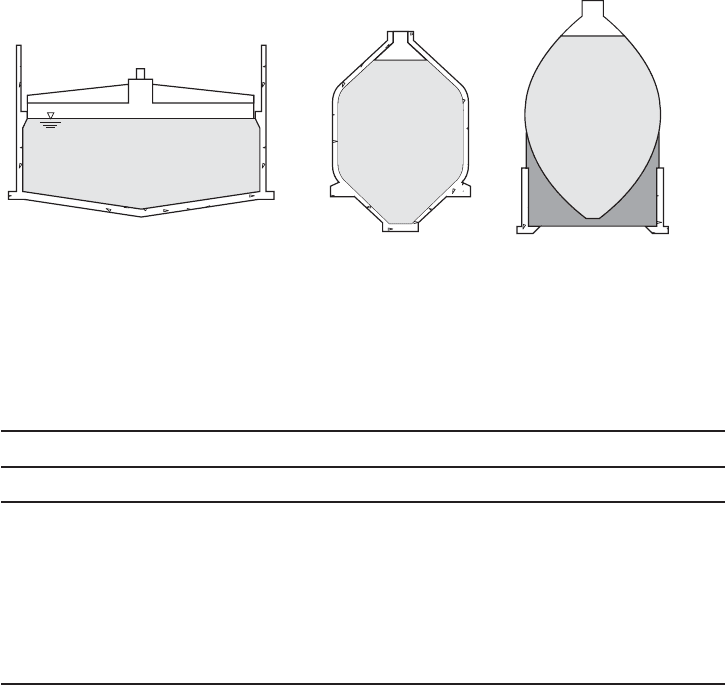
WASTEWATER PLANT RESIDUALS MANAGEMENT 27-43
The remainder of the discussion on anaerobic digestion focuses on high-rate digestion.
Tank Design. Essentially all of the modern digester designs in the United States are either cylin-
drical or egg-shaped ( Figure 27-15 ). The advantages and disadvantages of the two types are summa-
rized in Table 27-14 . Site constraints are a major con
sideration in selecting the digester shape.
The cylindrical shapes are the most common in the United States, but the egg shapes are
growing in popularity. This is especially true for plant expansion when space is limited.
C ylindrical tanks are seldom less than 6 m or more than 40 m in d iameter. The water
depth should not be less than 7.5 m at the
sidewall because of the difficulty of mixing shallow
tanks. They may be up to 14 m deep. For tanks provided with a suction mechanism for sludge
withdrawal, a bottom slope not less than 1:12 (vertical to horizontal) is recommended. For gravity
withdrawal, a minimum bottom slope of 1:6 is sugge
sted. Slopes greater than 1:3, although desir-
able for grit removal, are difficult to construct and hard to work on during cleaning (GLUMRB,
2004; Metcalf & Eddy, 2003; WEF, 1998). These tanks are commonly constructed of concrete.
(c)(b)(a)
FIGURE 27-15
T ypical shapes of anaerobic digesters: (a) cylindrical with reinforced c onc rete construction, (b) conven-
tional German design with reinforced concrete construction, and (c) egg-shaped with steel shell.
( Source: Metcalf & Eddy, 2003.)
TABLE 27-14
Comparison of cylindrical and egg-shaped anaerobic digesters
Type of digester
Cylindrical Egg-shaped
Large volume for gas storage Virtually no gas storage volume
Poor mixing efficiency High mixing efficiency
High grit and silt accumulation
a
Minimum grit accumulation
Large surface area for scum accumulation
a
Reduced scum formation
Conventional construction Specialized construction
Larger footprint (lower volume/unit area) Smaller footprint (larger volume per unit area)
Lower unit cost ($/m
3
of volume) Higher unit cost ($/m
3
of volume)
a
S ubmerged, fixed cover design introduced in early 1990s limits scum build-up, and continuous removal of
sludge from the bottom of the digester reduces grit accumulation.
Sources: Metcalf & Eddy, 2003; Witzgall et al., 1998.
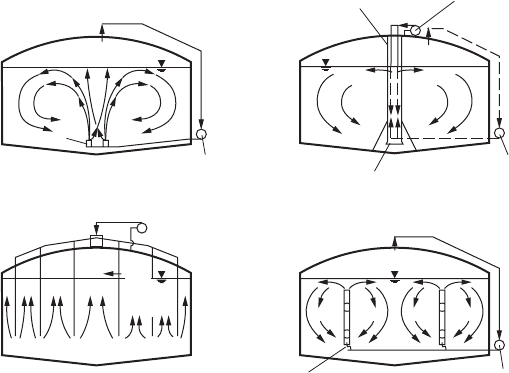
27-44 WATER AND WASTEWATER ENGINEERING
Fewer data are available on the dimensions of egg-shaped digesters, but diameters of up to 25 m
and heights in excess of 40 m have been reported. The bottom slope is on the order of 45 degrees
from the horizontal. Although they can be built of concrete, typically they are constructed of steel.
Mixing Systems. Mixing of the digester contents is essential for high-rate digestion. If feed solids
concentrations exceed 6 to 6.5 percent, good mixing may be difficult to achieve (Shimp et al., 1995).
The three alternative mixing systems are gas injection, mechanical stirring, and mechanical pumping.
The gas produc
ed as a result of the anaerobic digestion processes is used for mixing.
In unconfined systems the compressed gas is released through bottom diffusers or lances
( Figure 27-16 a). As the bubbles rise to the surface they carry sludge upwards and
stir the tank
contents. The confi ned systems employ an eductor or draft tube that carries the gas from the
bottom of the tank to the surface ( Figure 27-16 b). The diffuser systems are difficult to maintain.
Mechanical mixers may be low-speed turbines or low-speed mixers. Mechanical mixing sys-
tems are limited because of the wear of impellers, bearing failures, and gas leaks at the seals.
P umping systems withdraw a portion of the biomass and reinject it tangentially through noz-
zle
s at the bottom of the tank. A high-flow, low-head solids handing pump is used.
Gas Safety. Digester gas and air must not be allowed to mix because of the potential for
fire and explosions. The explosive range is defined by the Lower Explosive Limit (LEL) and
Higher Explosive Limit (HEL) or Upper Explosive Limit (UEL). Mixtures of hydro
carbons, such
as methane, and air that have such low concentrations that they cannot be ignited are below the
LEL. Mixtures that have such high concentrations in air that ignition is not possible until more air
Diffusers
Gas
compressor
Bottom diffusers
Gas lifter
Gas
compressor
(optional)
Mounted
to cover
Gas
compresso
r
Cover-mounted lances
Gas pistons
(optional)
Gas
compressor
Gas
compressor
Bubbles
Bubble
generator
Gas
injection
system
Bubbles
(a)(b)
FIGURE 27-16
Devices used for mixing contents of anaerobic high-rate digesters: (a) unc onfined
gas-injection systems, (b) confined gas-injection systems.
( Source: Metcalf & Eddy, 2003.)
WASTEWATER PLANT RESIDUALS MANAGEMENT 27-45
is added are said to be above the HEL. The LEL for methane is 5.0 percent by volume. The HEL
is 15.0 percent by volume (LaGrega et al., 2001).
Some of the design features that are provided to minimize the potential for explosions are
vacuum and pressure relief valves, drip traps, flame traps, and automatic thermal shutoff valves in
the gas colle
ction/piping system. Explosion proof switches and light fixtures as well as explosion-
proof vent fans for positive ventilation are provided in work areas. Gas detectors for methane,
oxygen, and hydrogen sulfide,with alarm systems are recommended. Self-contained breathing
units and appropriate personal protective equipm
ent (PPE) must be provided for work inside the
tanks (GLUMRB, 2004; WEF, 1998).
A waste-gas burner is provided to safely flare excess gas to the atmosphere. It should have
an all-weather pilot with an ignition system. Natural gas or propane should be used to fuel the
pilot to provide a steady reliable flame. The waste-gas burner should be at least 15 m fro
m the
digesters or gas-holder tanks (WEF, 1998).
The following resources provide additional guidance on safety features: National Electric Code
(NFPA, 1993), Standards for Fire Protection in Wastewater Treatment and Collection Facilities
(NFPA, 1995), Safety and Health in Wastewater Systems (WEF, 1994), and GLUMRB, 2004.
Gas Collection. The gas is collected under the c
over in cylindrical digesters. The covers may be
floating, fixed, or membrane. Floating covers ( Figure 27-17 ) allow the volume of the digester to
change without allowing air to enter. When fixed covers are used, provisions must be made so that
when the liquid volume changes, gas, and not air, will be drawn into the digester. One alternative
is to provi
de external gas storage. Membrane covers ( Figure 27-18 ) consist of a support structure
and flexible membranes for air and gas. A blower is provided to pressurize the air space.
E xternal storage is provided for egg-shaped digesters. Pressure-type tanks usually are
spheres that hold the gas at pressures from 140 to 700 kPa. Typical values are on the order of
140 to 350 kPa.
Gas storage capacity of at least 25 to 33 percent of the daily gas production should be provided.
Gas Piping. The
main gas collector line from the digester should be greater than 65 mm in
diameter. Large systems may require lines 200 mm or more in diameter. The intake should be at
least 1.4 m above the liquid level. The pipe slope should not be less then 10 mm/m. A pipe slope
of 20 mm/m is recommended to provide for drainage of
condensate. The gas velocity should
be limited to 3.4 to 3.5 m/s to maintain acceptable line pressure losses and prevent carryover of
moisture from condensate traps.
Most systems operate at pressures less than 3.5 kPa.
Gas Use. Methane from anaerobic digesters is a valu
able energy source. In many plants, it is
used as a fuel for boiler and internal-combustion engines that provide electricity or motive power
for pumps, blowers, and other plant energy needs. A primary use is in heating sludge to maintain
the mesophilic temperature in the range between 30 C and 38 C. In very large plants, ex
cess
methane may be sold to local utilities.
Because digester gas is only 65 percent methane, its lower heating value is less than that of
natural gas. The lower heating value ranges from 20 to 25 MJ/m
3
. Typically , a lower heating
value of approximately 22.40 MJ/m
3
i s used in design calculations. For comparison, the lower
heating value of natural gas is about 37.3 MJ/m
3
(Metcalf & Eddy, 2003; WEF, 1998).
Digester gas contains hydrogen sulfide, particulate matter, and water vapor. These must be
removed by gas scrubbing equipment before it can be used in internal-combustion engines that
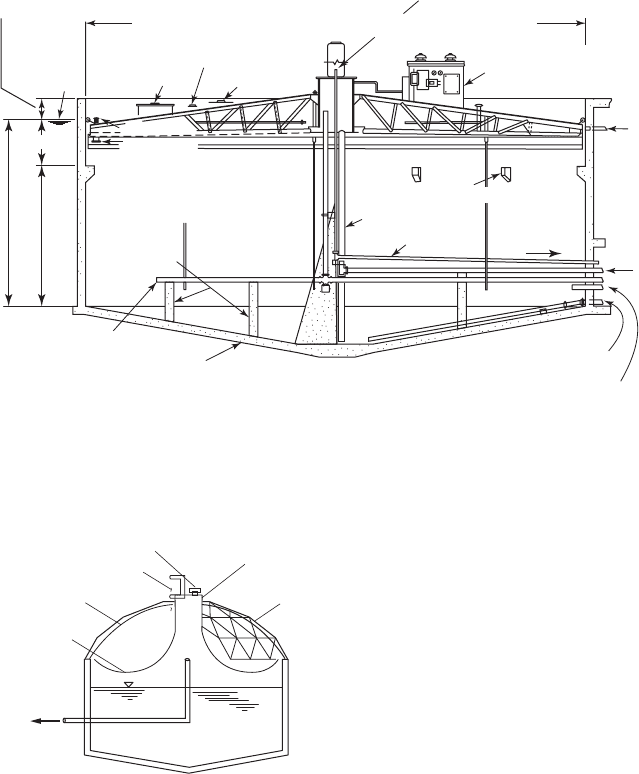
27-46 WATER AND WASTEWATER ENGINEERING
Freeboard
0.6 m to 15 m diam.
0.75 m above 15 m
High
water
level
Sampling well with
quick-opening cover
Entrance
hatch
Access manhole
Inside dia
meter – Select even 1.5 m increments for standard covers
Gas pipe must be centered
in tank and extend 1.2 m
above max liquid level
Gas rec
irculation
system for increased digester
activity and elimination of scum
Digester liquor
drawoff
Digester liquor
overflow
Slope
Digested sludge
drawoff
Bottom slope
approximately 1 in 6
Additional raw
sludge inlet and
recirculation
discharge
2.4 m
Side-water depth
Concrete pipe
supports
Drain sump
High-level recirculation
discharge and gas pipe
must be securely anchored
to concrete support frame
Recirculat
ion
suction
Gas takeoff
Supernatant
selector
Sump well
Landing ledge or brackets
FIGURE 27-17
Cross section detail of an anaerobic digester with a floating cover. (Courtesy of Envirex.)
Pressure/vacuum
relief valve
Center gas
dome
Reticular dome
structure
Air supply/bleed
Air membrane
Gas membrane
Digester gas
inlet/outlet
FIGURE 27-18
Anaerobic digester with membrane gas cover. (Source: Metcalf &
Eddy, 2003.)
are used to drive generators. Hydrogen sulfide is particularly corrosive as well as extremely toxic
at low concentrations. Special attention must be given to its removal for successful use of the
digester gas.
Digester Heating. The slud ge in anaerobic digestion tanks is heated by pumping the sludge
through an external heat exchanger and returning it to the tank. An energy balance is used to
determine the feasibility of using digester gas to maintain the temperature of the digester in the
mesophilic range. The energy balance includes the energy to raise the temperature of the incom-
ing sludge to the digestion tank, the energy to compensate for heat losses, and lo
sses in transport
from the tank and the heat exchanger.

WASTEWATER PLANT RESIDUALS MANAGEMENT 27-47
A basic assumption in computing the energy balance is that the specific heat of sludge and
that of water are essentially the same, that is, 4.186 kJ/kg · K. The heat addition required to raise
the temperature of the incoming sludge is estimated by the following equation:
qMCTT
rslp
()()( )
21
(27-27)
where q
r
heat required, kJ/d
M
sl
mass of sludge, kg/d
C
p
specific heat of water 4.186 kJ/kg · K
T
1
temperature of sludge entering digester, K
T
2
temperature of sludge in digester, K
Heat losses from the digester are computed using the following expression:
qUAT
L
()()( )
(27-28)
where q
L
heat loss, J/s
U overall coefficient of heat transfer, J/m
2
· s · K or W/m
2
· K
A cross-sectional area through which the heat is lost, m
2
T temperature change across the surface, K
Typical values of heat transfer coefficients are shown in Table 27-15 .
TABLE 27-15
Typical values of heat transfer coefficients for anaerobic digesters
Structural composition
U, W/m
2
· K
Concrete walls above ground
300 mm thick, not insulated 4.7–5.1
300 mm thick with air space and brick facing 1.8–2.4
300 mm thick with insulation 0.6–0.8
Concrete walls below ground
Surrounded by dry soil 0.57–0.68
Surrounded by moist soil 1.1–1.4
Concrete floor
300 mm thi
ck in contact with dry soil 1.7
300 mm thick in contact with moist soil 2.85
Floating cover
35 mm wood deck, built-up roofing, no insulation 1.8–2.0
25 mm insulating board installed under roofing 0.9–1.0
Fixed concrete cover
100 mm thick, built-up roofing, not insulated 4.0–5.0
100 mm thick, b
uilt-up roofing, 25 mm of insulation 1.2–1.6
225 mm thick, not insulated 3.0–3.6
Steel cover
6 mm thick 4.0–5.4
Source: Metcalf & Eddy, 2003.
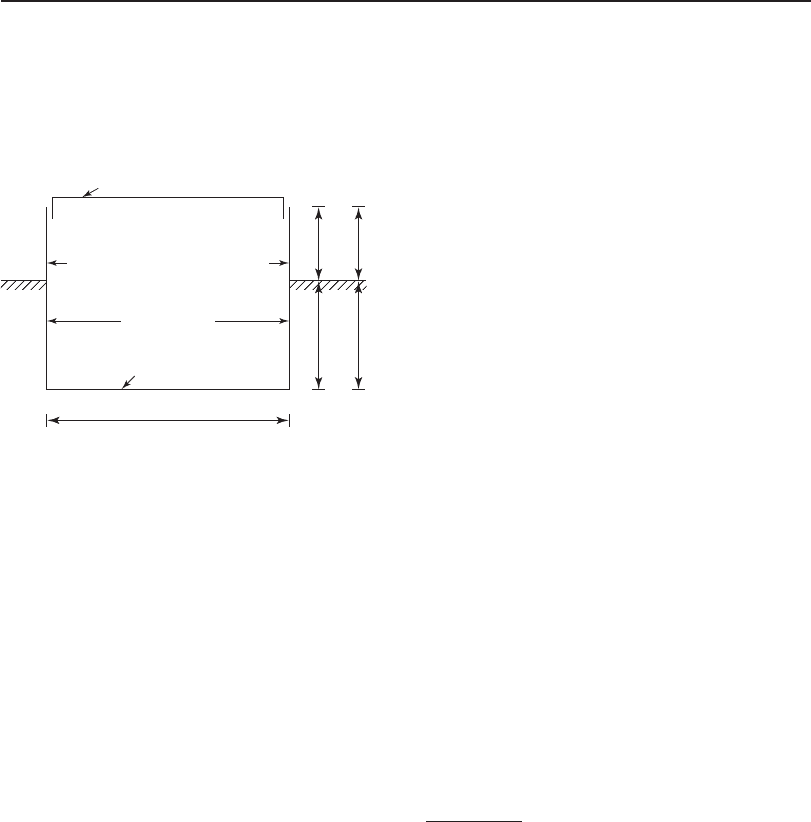
27-48 WATER AND WASTEWATER ENGINEERING
B e cause the heat losses from the tank warm the soil, it is assumed that approximately 1.5 to
3 m of the soil from the digester is warmed before ambient ground temperatures are achieved.
In cold climates, frost may penetrate to a depth of 1.2 m or more. Thus, the ground temperature
may be a
ssumed to be 0 C at this depth. Below 1.2 m, normal winter ground temperatures can be
assumed. In the absence of actual data, a cold climate winter ground temperature of 5 C at a depth
of 2 m may be assumed. The ground temperatures are 5C to 10 C higher at the base of the wall.
Heat transfer requirement
s must also include the efficiency of the heat exchanger.
E xample 27-7 illustrates the estimation of the heating requirements for an anaerobic digester
in a cold climate.
Example 27-7. Evaluate the feasibility of heating the digester designed for Omega Three
(Example 27-6) with the methane produced in the digester. The proposed digester des
ign and
temperatures are given in the sketch below. Ignore the slope of the bottom of the digester in
calculating the area of the bottom. The mean temperature in January is 8 C. The incoming
sludge temperature is 10 C. Assume conservative values for U, a heat exc hange efficiency of
80%, and a lower heating value for methane of 22.40 MJ/m
3
.
Moist soil
25 mm insulated floating cover
31 m
300 mm thick concrete
3.0 m
4.5 m
8 C at wall
Average
9C at
wall
Moist soil
300 mm thick concrete w/insulation
Plain concrete
Digester temperature 35C
Solution:
a . Compute the heat requirement to raise the sludge temperature to the digester tempera-
ture. From Example 27-3, the mass of sludge is 3,461 kg per pumping cycle and there
are three pumping cycles per day.
q
r
()()(3 461 3 4 186,.kg/cycle cycles/d kJ/kg KKK
KK
)[( )
()]
273 15 35
273 15 10
10
.
.
.99 10 1 09 10
69
kJ/d J/d.
b. Compute the areas for the walls, roof, and floor.
Wall area above groundmm()( )( ) 31 3 292 2. m
Wall area below groundmm
2
3145 ()( )( ) .
438 3
31
4
7548
2
2
2
.
.
m
Roof area
m
m
Flo
()( )
oor area Roof area

WASTEWATER PLANT RESIDUALS MANAGEMENT 27-49
c. Compute the heat loss by conduction using Equation 27-28.
Wall above ground:
q
L
()()()(0 8 292 2 35 8 86 400
22
.. ,W/m K m CC s/d J/d)868 10
8
.
Wall below ground:
q
L
()()()(14 438 335 98640
22
.. ,W/m K m CC 0013810
9
s/d J/d).
Roof:
q
L
()()()(10 7548 35 88640
22
.. ,W/m K m CC 002810
9
s/d J/d).
Floor:
q
L
()()()(285 7548 35 9864
22
.. ,W/m K m CC 000 4 83 10
9
s/d J/d).
d. The total capacity of the heat exchanger required is
Capacity J/d J/d 1 09 10 8 68 10 1 3810
989
...J/d J/d J/d
J/
28 10 483 10
10 10
99
10
..
.1 dd
e. With a heat exchanger efficiency of 80%, the lower heating value of the fuel must be
10 10
08
1 3710 1 10
10
10 4
.1
.
..4
J/d
J/d MJ/d
f. The methane produced by the digester has a lower heating value of
()( )395 3 22 40 8 9 10
333
.. .m /d MJ/m MJ/d
The methane production will not be enough to maintain the digester temperature during
January.
Comments:
1 . Note that this assessment is the worst case scenario, that is, January. For months with
more moderate temperatures, the digester should be self-sustaining.
2. The options for design to overcome the the need for
more energy to maintain the tem-
perature include auxiliary fuel, storing methane during the warmer months, and increas-
ing the insulation to reduce the heat loss.
Heat Exchangers. Although internal heating systems have been used, they have inherent operat-
ing and maintenance problems. Their use is not recommended. External heat exchangers may be of
the tube-in-tube, spiral-plate, or water-bath type. Flow of the heating fluid (typically water) is coun-
tercurrent to the flow of sludge. Water temperatures are typically held below 68 C to keep sludge

27-50 WATER AND WASTEWATER ENGINEERING
from caking on the exchanger. Heat transfer coefficients are on the order of 0.9 to 1.6 kJ/m
2
· K.
The efficiency of the heat exchanger may range from 60 to 90 percent.
Anaerobic Digestion Design Criteria. Typical anaerobic digester kinetic des ign parameters
are summarized in Table 27-13 . Typical physical design parameters for anaerobic digesters are
summarized in Table 27-16 .
Operational Considerations
The anaerobic digestion process is sensitive to changes in operating conditions. Of the numerous
parameters that can affect operation, four are particularly noteworthy: temperature, uniform
feeding, pH, and ammonia. These are important in ensuring effective gas production and avoid-
ing digester upsets. The need for temperature s
tability was discussed earlier in this section. Uni-
form feeding, pH, and ammonia are discussed in the following paragraphs.
Uniform Feeding. For single-stage high-rate digesters, sludge should be pumped to the digester
continuously or on a 30-min to 2-h cycle to help m aintain constant conditions in the dige
ster.
Where cycles of 8 or 24 h are the only ones practical, it is important to withdraw digested sludge
from the digester before adding the feed sludge because the pathogen kill is significantly greater.
pH Control. The effective range for methanogens is a pH from 6.5 to 7.5, with an optimum
range of 6.8 to 7.2. The stability of the digestion process depends on the bu
ffering capacity
of the digester contents and the production of carbon dioxide. The normal operating range is
dependent on the relationship between bicarbonate alkalinity, pH, and carbon dioxide as shown
in Figure 27-19 .
TABLE 27-16
Range of physical design criteria for high-rate anaerobic digester facilities
Parameter Range of values Comment
Feed concentrations 2–6% 4% preferred
6% will have mixing problems
Tank (cylindrical)
Diameter 6–40 m
Depth 6–15 m 7.5 m preferred
Bottom slope 1:3 to 1:6 1:6 preferred for gravity withdrawal
Mixing
Mechanical 5–8 W/m
3
Gas (unconfined) 0.27–0.30 m
3
/m
3
· h m
3
of gas/m
3
of digester volume
Gas (confined)0.30–0.42 m
3
/m
3
· h
Gas production 0.75–1.12 m
3
/kg VSS destroyed
Lower heating value 20–25 MJ/m
3
22.4 MJ/m
3
typical
Heat exchanger transfer coefficient 0.9–1.6 kJ/m
2
· K External heat exchanger
Sources: Metcalf & Eddy, 2003; Shimp et al. 1995; WEF, 1998.
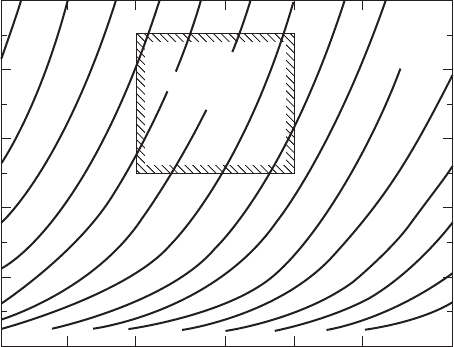
WASTEWATER PLANT RESIDUALS MANAGEMENT 27-51
Upset of a digester operation known as a stuck digester or a sour digester results from the
following sequence of events: (1) increasing volatile ac ids and low alkalinity that results in a
decreasing pH, and (2) inhibition of the methanogens that results in a drop in methane produc-
tion and foaming. As an operational tool, pH measurements have limited value. By the time the
alkalinity ha
s been destroyed and the volatile acid concentration has risen enough to depress the
pH, the digester is already “stuck.”
Alkalinity, volatile acids, and gas analysis are of much more value in assessing the operation
of the digester. Falling alkalinity and increasing volatile acid concentrations are warning signals
of impending trouble. Some rules-of-thumb are:
• If the volatile acid concentration is within 1,000 mg/L of the alkalinity concentration, there
is a danger of a pH drop;
• An alkalinity of 500 to 1,000 mg/L as CaCO
3
provides a very small margin of safety;
• An alkalinity of 2,500 to 5,000 mg/L as CaCO
3
provides a large margin of safety;
• Volatile acid concentrations should be in the range of 50 to 300 mg/L.
If the percentage of CO
2
in the digester gas ris es from 30–40 perc ent and the CH
4
percentage
falls from 60–70 percent, this is also an indicator of impending trouble.
The suggested remedies are: stop feeding, increase the alkalinity by concentrating the sludge,
and carefully add of NaHCO
3
. Other pH control methods include reseeding the digester with
actively digesting microorganisms and by scrubbing the CO
2
from the digester gas before it is
recirculated back to the digester for mixing (Andrews, 1969). The addition of lime is not recom-
mended as the strong base may result in the formation of precipitates and, potentially, an over-
dose that results in too high of a pH.
Ammonia Control. Ammonia formation results from the breakdown of protein. The ammonia
normally
combines with carbon dioxide to form NH
4
(HCO
3
). With excess free ammonia in
250
10
20
30
40
50
6.0
6.4
6.6
6.8
7.0
7.2
7.4
7.6
7.8
8.0
8.2
8.4
8.6
8.8
PH
6.2
0
500 1,000 2,500
Limits of
normal anaerobic
treatment
Bicarbonate alkalinity, mg/L as CaCO
3
CO
2
in digester gas, %
5,000 10,000 25,000
FIGURE 27-19
Relationship between pH and bicarbonate
concentration (35 C).
( Source: McCarty, 1964.)
27-52 WATER AND WASTEWATER ENGINEERING
solution, the pH is high and the volatile acid concentration is high, but there is no gas production.
This situation is termed ammonia toxicity. Inhibitory concentrations of total ammonia-nitrogen
have been reported in the range of 1,500 to 3,000 mg/L at a pH above 7.4. At concentrations
above 3,000 mg/L, ammonia-nitrogen may be toxic at any pH (McCarty, 1964; WEF, 1998).
A cclim
ation to high total ammonia-nitrogen concentration can be achieved over long periods
of time (Parkin and Miller, 1982). The suggested remedy in the short-term is to carefully add small
amounts of HCl to lower the pH. H
2
SO
4
i s to be avoided as it may result in sulfide toxicity.
27-10 SLUDGE CONDITIONING
S l udge is conditioned to improve dewatering characteristics. Conditioning by the addition of
chemicals is the predominant method used in the United States. It is the focus of this discussion.
Heat treatment is used to a limited extent. It will be discussed more briefly.
Chemical Conditioning
Chemical conditioning results in coagulation of the solids and release of the absorbed water.
The most common coagulants are ferric chloride, lime, or organic polymers. Ash from incinerated
sludge has also found use as a conditioning agent. Ash, ferric chloride, and lime in c
ombination are
effective but result in an increase of 20 to 30 percent in the dry solids that must be disposed.
Application of organic polymers has become typical for sludge conditioning because they
do not increase the dry solids. They are easy to handle, require little storage spac
e, and are very
effective. They also are very expensive.
Chemical Selection and Dosage. Polymers are frequently used when dewatering is to take
place with centrifuges or belt filter presses. Lime and ferric chloride are often used when pressure
filtration is the method selected for dewatering.
The dosage is determined by routine laboratory testing. The
commonly used tests include
the Buchner funnel test for determination of specific resistance, capillary suction test time, and
standard jar tests. For belt-filter presses, typical polymer dosages range from 1 to 8.5 kg/Mg of
dry solids.
Chemical Application. Chem
icals are most easily applied and metered in liquid form. Dry
chemicals are dissolved in day tanks. Polyvinyl chloride, polyethylene, and rubber lined tanks are
suitable. Corrosion resistant metering pumps are used. Typically, these are positive dis
placement,
variable speed pumps (Metcalf & Eddy, 2003).
The chemical dosing point may be an important factor in determining the size of the dose.
The polymer does not mix and react with the biosolids instantaneously. The provision of polymer
addition points 9 to 12 m and 18 to 24 m ahead of the dewatering device provide
s the operator flex-
ibility in selecting the best option. For centrifuges, internal addition is often the best (LaMontagne
and Yevilevich, 2006).
Mixing. The selection of the mixing system is dependent on the dewatering method. Separate
mixing and flocculation tanks are typically provided ahead of pressure filters. If a belt-filter
press is to be used, either an upstrea
m flocculation tank or direct addition to the feed line may be
employed. In-line mixers are typically used with centrifuges.
